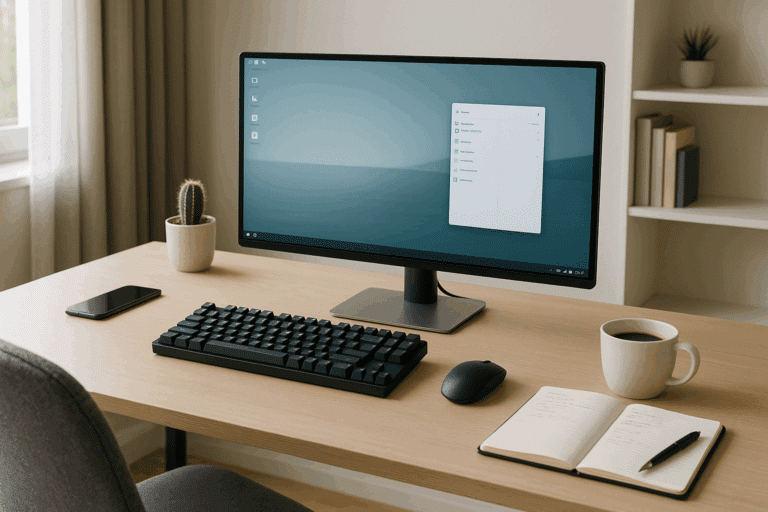Imagine a future where your workspace is no longer a monotonous cubicle or a cluttered desk at home, but a dynamic, digital haven designed for maximum productivity and satisfaction. 😊 Think about an environment that not only fuels your efficiency but also inspires creativity and innovation. This is not a distant fantasy but a rapidly evolving reality, as technology reshapes the way we work and interact with our workspaces. Welcome to the realm of crafting your dream digital workspace! 💻
Our focus in this comprehensive guide will be to unlock the potential of the digital workspace, a concept that has gained substantial momentum in recent years. We’ll delve into its fundamentals, explore the tools and technologies powering it, and ultimately guide you in designing a digital workspace that is a perfect fit for your unique needs. 💡
What Awaits You in this Guide
There’s a plethora of exciting topics that we’ll be dissecting in this exhaustive exploration. To begin with, we’ll lay a solid foundation by understanding what a digital workspace truly means in the current context and why it matters more than ever. We’ll then map out its evolution, tracing the journey from the physical to the virtual, to the hybrid models we see emerging today.
Next, we’ll guide you on a journey through the cutting-edge technologies transforming the modern workspace, from cloud-based solutions to AI-driven tools. 🚀 The goal is to familiarize you with the best of the breed technologies that can empower your workspace transformation.
Following this, we’ll delve into the intricacies of designing a digital workspace. This includes defining your needs, selecting the right tools, and implementing them effectively. This section will be rich in practical insights and actionable strategies that you can start implementing right away.
Why this Guide is a Must-Read
Whether you’re a solopreneur looking to boost productivity, a team leader aiming to foster collaboration, or a business owner striving to improve operational efficiency, this guide will serve as your roadmap. It’s not just about selecting the right digital tools; it’s about understanding how to use these tools to craft a workspace that resonates with your work style, enhances your productivity, and amplifies your satisfaction.
Finally, we’ll discuss the future of digital workspaces, examining emerging trends and innovations that promise to further transform our work environment. This will provide you with a glimpse of what lies ahead, preparing you for the future of work.
The task of crafting your dream digital workspace may appear daunting initially, but as we break down the process into manageable steps, it will seem less like a mammoth task and more like an exciting adventure. 🎯 So, let’s embark on this journey together and turn the dream of a productive, satisfying, and innovative workspace into reality.
This in-depth exploration of the digital workspace will be packed with technical details, real-life examples, and expert insights. However, it will be presented in a language that is easily understandable, irrespective of your technical proficiency. So, whether you’re a seasoned IT professional or a novice in the realm of digital workspaces, there’s something valuable for you in this guide. 🌟
As we navigate through this transformative journey, we encourage you to keep an open mind, question existing norms, and embrace new ways of working. After all, the key to a successful workspace transformation lies in challenging the status quo and daring to dream big. So, are you ready to craft your dream digital workspace? Let’s get started! 🚀
Introducing Your Digital Workspace: A New Frontier for Productivity and Satisfaction
With the rapid advancement of technology and the shift towards remote work, the concept of a workspace is undergoing a dramatic transformation. The classic office cubicle is slowly being replaced by more flexible and efficient digital workspaces. These platforms, made possible by state-of-the-art technology, provide an all-in-one solution for collaboration, communication, and productivity. But what does it take to craft your dream digital workspace? How can you optimize your work environment for maximum productivity and satisfaction?
To answer these questions, it’s essential to first understand what a digital workspace is and how it operates. In essence, a digital workspace is a technology framework that centralizes and virtualizes all of your work resources. This includes everything from your applications and data to your team collaborations and business processes. The ultimate goal is to provide you with access to everything you need for your work, no matter where you are or what device you’re using.
Now, let’s delve deeper into the intricacies of creating the perfect digital workspace for you and your team. We will examine the critical elements you need to consider, the common challenges you might face, and the best practices to follow for optimal productivity and satisfaction.
Essential Elements of an Ideal Digital Workspace
Designing an effective digital workspace requires careful consideration of various elements, each contributing to the overall functionality and user experience. Here are some of the key components you need to factor in when crafting your dream digital workspace:
User Experience (UX)
The user experience (UX) is arguably the most crucial aspect of any digital workspace. It influences how your team interacts with the platform, affecting their productivity and satisfaction levels. A user-friendly interface, intuitive navigation, and personalized features can significantly enhance the UX, leading to higher engagement and better performance.
Security
As digital workspaces house sensitive company data, robust security measures are essential. These can include encryption, multi-factor authentication, and stringent access control. By ensuring that your digital workspace is secure, you not only protect your data but also build trust with your team.
Collaboration and Communication Tools
Effective communication and collaboration are the lifeblood of any team. Therefore, your digital workspace should incorporate tools that facilitate seamless interactions, such as video conferencing, instant messaging, and shared workspaces.
For a visual representation of how these elements interplay, see the table below:
| Element | Function | Example |
| User Experience (UX) | Enhances interaction with the platform | Intuitive navigation |
| Security | Protects sensitive data | Multi-factor authentication |
| Collaboration and Communication Tools | Facilitates team interactions | Video conferencing |
For a more comprehensive understanding of these elements, check out the YouTube video titled “Building a Digital Workspace for the Future” from the channel “VMware.”
Challenges in Creating a Digital Workspace and How to Overcome Them
While the benefits of a digital workspace are numerous, the path to creating one isn’t devoid of challenges. These can range from technical hurdles to cultural resistance. However, by identifying these challenges early on and taking proactive measures, you can successfully overcome them.
Technical Challenges
Technical challenges can include compatibility issues, network connectivity problems, and software bugs. To address these, it’s crucial to invest in high-quality technology and maintain regular system updates. You might also consider hiring a dedicated IT team to manage and troubleshoot any technical issues that arise.
Cultural Resistance
Transitioning to a digital workspace often involves a significant shift in work habits and routines. This can lead to resistance from team members who are comfortable with traditional work environments. To overcome this, it’s important to foster a culture of openness and flexibility. You can also provide training and support to help team members adapt to the new platform.
Data Security Concerns
Data security is another significant concern when it comes to digital workspaces. To mitigate this risk, it’s essential to implement robust security measures and educate your team about safe online practices. Regular audits and security updates can further ensure that your digital workspace remains secure.
Best Practices for an Optimal Digital Workspace
Once you’ve considered the key elements and addressed the potential challenges, it’s time to focus on best practices. These strategies can help you optimize your digital workspace for maximum productivity and satisfaction.
1. Customize for Your Needs
Every team is unique, with different needs and preferences. Therefore, it’s important to customize your digital workspace to fit your specific requirements. This could involve choosing the right tools and features, personalizing the interface, or adjusting the settings for optimal performance.
2. Encourage Collaboration
Collaboration is at the heart of a successful digital workspace. Encourage your team to use the platform’s collaboration tools, such as shared documents, group chats, and video conferences. This can enhance teamwork and boost productivity.
3. Regularly Review and Update
Lastly, a digital workspace is not a set-and-forget solution. Regular reviews and updates are necessary to ensure it continues to serve your needs effectively. This could involve adding new features, improving security measures, or updating the user interface.
By incorporating these best practices, you can ensure that your digital workspace is not only efficient and secure but also a place where your team enjoys working.
For more insights into creating a successful digital workspace, watch the YouTube video titled “Digital Workspace Best Practices” by “Digital Workspace Tech Zone”.

Conclusion
In conclusion, it is evident that the digital sphere we exist in today is built on the bedrock of IT and engineering. As we have discussed in detail throughout this article, these fields are integral to the smooth functioning of a myriad of industries, and the importance of a solid grounding in these areas cannot be overstated. 💡
From the essentiality of understanding coding languages like Python and JavaScript, to the importance of grasping the complexities of network architectures, data structures, and algorithms, we have delved into the technicalities of IT and engineering. 🧑💻
Moreover, we’ve discussed the key role played by various software development methodologies such as Agile, DevOps, and Waterfall. Also, we’ve touched upon emerging technologies like Artificial Intelligence, Machine Learning, and Blockchain, and their profound implications for the future of these fields. 🤖
We’ve also highlighted the relevance of cybersecurity, a field that has grown exponentially in importance as our dependence on digital systems increases. Cyber threats are becoming more sophisticated, and the need for capable, skilled professionals to combat these threats is rising. 🛡️
Additionally, we’ve explored how the principles of IT and engineering influence and shape critical areas like product development, project management, and business strategy. The versatility of these skills allows professionals to apply their knowledge across different sectors and roles, enhancing their career prospects and ability to contribute to the growth of their organizations. 🚀
Finally, we’ve underscored the value of continuous learning and professional development in these ever-evolving fields. As new technologies emerge, professionals must adapt and acquire new skills to stay ahead of the curve. 📘
Through this article, we hope that we’ve not only enhanced your understanding of these complex topics but also ignited a spark of curiosity to delve deeper into these fascinating subjects. We encourage you to leverage this knowledge, whether it’s to enhance your career prospects, improve your academic understanding, or satisfy your intellectual curiosity.
Feel free to share this article with your colleagues or anyone who might find it beneficial. And do not hesitate to leave your comments below. We’d love to hear your thoughts and any experiences you might want to share related to these topics.
Remember, each day offers a new opportunity to learn and grow. Embrace it with open arms! 🌱
To further enrich your understanding, here are some additional resources that can be accessed:
– [Python for Everybody](https://www.py4e.com/): A comprehensive free course on Python programming.
– [Codecademy](https://www.codecademy.com/): Learn coding in multiple languages including JavaScript.
– [MIT OpenCourseWare](https://ocw.mit.edu/): Free online courses from one of the world’s leading institutions on a variety of topics including AI, ML, and blockchain.
References:
– [Network Architecture](https://www.sciencedirect.com/topics/computer-science/network-architecture): An overview of network architecture principles.
– [Agile, DevOps, and Waterfall methodologies](https://www.atlassian.com/agile): A detailed exploration of various software development methodologies.
– [Cybersecurity](https://www.nist.gov/cyberframework): Information about the importance of cybersecurity in today’s digital world.
Keep learning, and remember – knowledge is power! 💪
tags: #IT #engineering #softwaredevelopment #cybersecurity #technology #learning #professionaldevelopment



